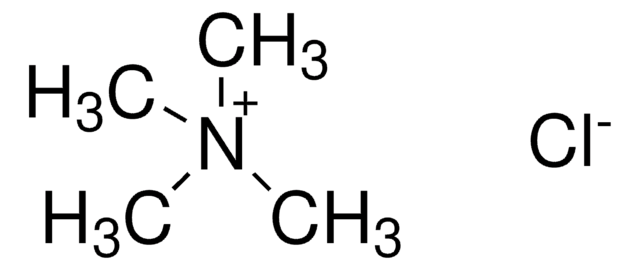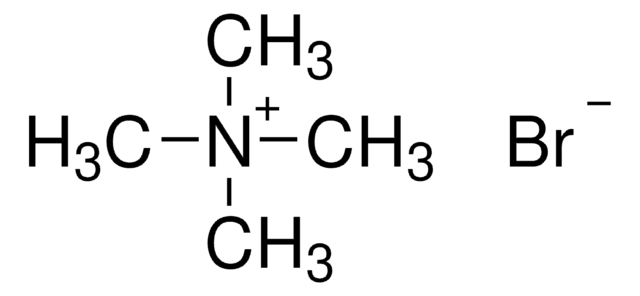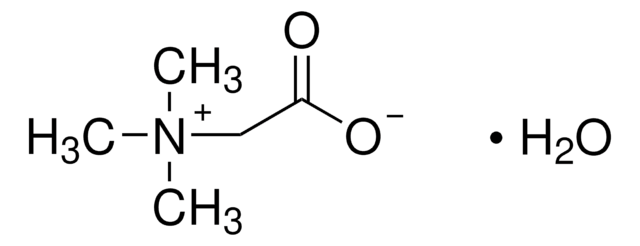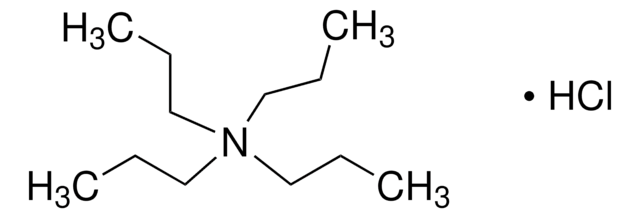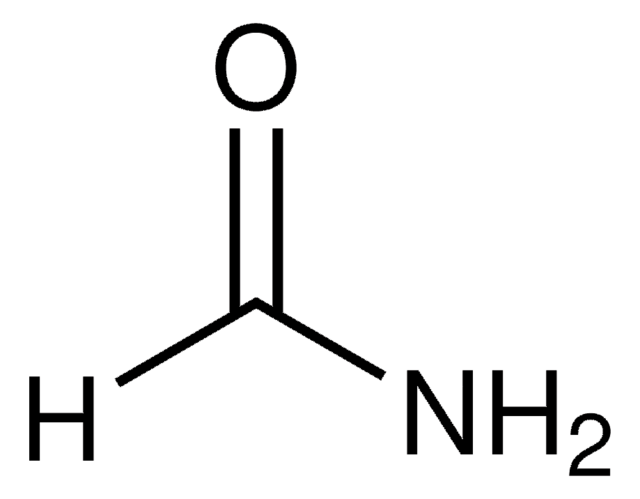87718
Tetramethylammonium chloride
BioUltra, for molecular biology, ≥99.0% (AT)
Sinonimo/i:
TMA
About This Item
Prodotti consigliati
Grado
for molecular biology
Livello qualitativo
Nome Commerciale
BioUltra
Saggio
≥99.0% (AT)
Stato
crystals
Impurezze
DNases, none detected
RNases, none detected
insoluble matter, passes filter test
phosphatases, none detected
proteases, none detected
Punto di fusione
>300 °C (lit.)
Solubilità
H2O: 6 M at 20 °C, clear, colorless
Anioni in tracce
bromide (Br-): ≤500 mg/kg
sulfate (SO42-): ≤50 mg/kg
Cationi in tracce
Al: ≤5 mg/kg
As: ≤0.1 mg/kg
Ba: ≤5 mg/kg
Bi: ≤5 mg/kg
Ca: ≤10 mg/kg
Cd: ≤5 mg/kg
Co: ≤5 mg/kg
Cr: ≤5 mg/kg
Cu: ≤5 mg/kg
Fe: ≤5 mg/kg
K: ≤50 mg/kg
Li: ≤5 mg/kg
Mg: ≤5 mg/kg
Mn: ≤5 mg/kg
Mo: ≤5 mg/kg
Na: ≤50 mg/kg
Ni: ≤5 mg/kg
Pb: ≤5 mg/kg
Sr: ≤5 mg/kg
Zn: ≤5 mg/kg
λ
1 M in H2O
Assorbanza UV
λ: 260 nm Amax: 0.02
λ: 280 nm Amax: 0.02
Stringa SMILE
[Cl-].C[N+](C)(C)C
InChI
1S/C4H12N.ClH/c1-5(2,3)4;/h1-4H3;1H/q+1;/p-1
OKIZCWYLBDKLSU-UHFFFAOYSA-M
Cerchi prodotti simili? Visita Guida al confronto tra prodotti
Applicazioni
- Estimating the nonideality of eutectic systems containing thermally unstable substances.: The paper explores the use of Tetramethylammonium chloride in studying the non-ideal behavior of eutectic mixtures, contributing to better thermal management in material science and engineering (Minceva M et al., 2023).
- Natural deep eutectic solvents as thermostabilizer for Humicola insolens cutinase.: This study examines how Tetramethylammonium chloride-based eutectic solvents can stabilize enzymes, enhancing their practical applications in biotechnological processes (Sisti L et al., 2023).
Altre note
Avvertenze
Danger
Indicazioni di pericolo
Consigli di prudenza
Classi di pericolo
Acute Tox. 2 Oral - Acute Tox. 3 Dermal - Aquatic Chronic 2 - Skin Irrit. 2 - STOT SE 1 Oral
Organi bersaglio
Central nervous system
Codice della classe di stoccaggio
6.1A - Combustible acute toxic Cat. 1 and 2 / very toxic hazardous materials
Classe di pericolosità dell'acqua (WGK)
WGK 3
Dispositivi di protezione individuale
Eyeshields, Faceshields, Gloves, type P2 (EN 143) respirator cartridges
Scegli una delle versioni più recenti:
Possiedi già questo prodotto?
I documenti relativi ai prodotti acquistati recentemente sono disponibili nell’Archivio dei documenti.
I clienti hanno visto anche
Il team dei nostri ricercatori vanta grande esperienza in tutte le aree della ricerca quali Life Science, scienza dei materiali, sintesi chimica, cromatografia, discipline analitiche, ecc..
Contatta l'Assistenza Tecnica.